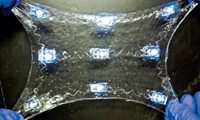Advertisement
Grab your lab coat. Let's get started
Welcome!
Welcome!
Create an account below to get 6 C&EN articles per month, receive newsletters and more - all free.
It seems this is your first time logging in online. Please enter the following information to continue.
As an ACS member you automatically get access to this site. All we need is few more details to create your reading experience.
Not you? Sign in with a different account.
Not you? Sign in with a different account.
ERROR 1
ERROR 1
ERROR 2
ERROR 2
ERROR 2
ERROR 2
ERROR 2
Password and Confirm password must match.
If you have an ACS member number, please enter it here so we can link this account to your membership. (optional)
ERROR 2
ACS values your privacy. By submitting your information, you are gaining access to C&EN and subscribing to our weekly newsletter. We use the information you provide to make your reading experience better, and we will never sell your data to third party members.
Materials
Hydrogels reinforced with rings on strings
Reversible crystallization of polyethylene glycol chains makes material tougher
by Bethany Halford
June 3, 2021
| A version of this story appeared in
Volume 99, Issue 21

Hydrogels have promise as tissue engineering scaffolds and in other biomedical applications. But these materials, which are made mostly of water held together by hydrophilic, cross-linked polymers, tend to be weak. To toughen up hydrogels, scientists have introduced sacrificial bonds: stretch the material, and these bonds break, dissipating energy so that rupturing the hydrogel is more difficult. These bonds can be slow to re-form, however, so the boost in strength doesn’t last.
Researchers at the University of Tokyo have come up with an alternative toughening strategy. A team led by Koichi Mayumi and Kohzo Ito created a hydrogel that contains polyethylene glycol chains threaded through pairs of covalently linked cyclodextrin rings to make a netlike structure (Science 2021, DOI: 10.1126/science.aaz6694).
When the hydrogel is stretched, the polymer chains slide through the rings, which maintain the cross-links between polymer strands. Stretch the polymer enough, and the polyethylene glycol crystallizes at points, increasing toughness. Studies show this slide-ring hydrogel is 10 times as tough as a hydrogel made from polyethylene glycol with conventional cross-links. The researchers say the slide-ring reinforcement strategy could be used with other gels made of semicrystalline polymers.




Join the conversation
Contact the reporter
Submit a Letter to the Editor for publication
Engage with us on Twitter